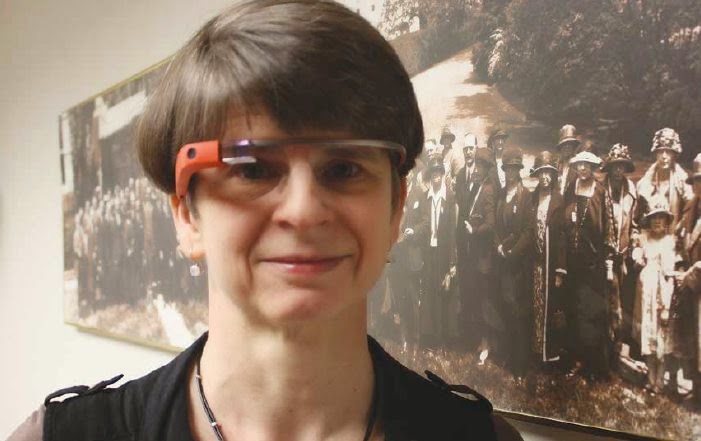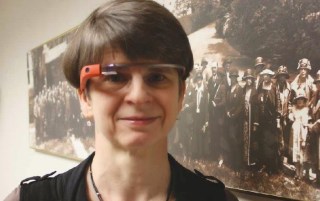
So, you may have seen me looking like this, lately.
Yup, that’s Google Glass. And that’s me trying not to be a Glasshole.
Neil Stimler, Digital Asset Specialist at the Met, has been sporting Glass for over a year and sharing his observations hashtagged #metthroughglass. Barry Joseph, Associate Director for Digital Learning at the American Museum of Natural History, recently blogged about his experience visiting DC museums with a borrowed set of Glass. I’ve been playing around with Glass for about six months now, porting it with me to conferences and speaking gigs, trying it out in various settings and thinking about what Glass could be good for in museums. This is my first stab at sharing these thoughts on the Blog.
If you haven’t had the chance to play around with Glass, this very brief intro demo gets across the basics:
It’s kind of the love child of an iPhone and Geordi La Forge’s VISOR from StarTrek TNG.
Here is the challenge: playing around with this tech for tech sake tends to yield experiments that could be done equally well (and less expensively) with other equipment. Artists and teachers, for example, have tried using Glass as a way of recording and sharing a “first person” view of what they are doing. But you could do the same thing, less expensively, with a GoPro camera. What can Glass do better than a head-mounted video camera, or even a hand-held internet connected devices? My smart phone can already connect to the internet, accept voice command and access location-specific information.
What distinguishes Glass from my phone is that it provides heads-up and (mostly) hands free access to these functions. These capabilities make Glass potentially valuable in an operating room for example, where immediate hands-free access to information could save a life. (Imagine a surgeon pulling up pre-op MRI images to guide her hand.) Less critically, but still fun, this teacher used Glass to not only share video but conduct a real time Google Hangout with students while he visited the Large Hadron Collider. What are the equivalent (fun or critical) applications in museums?
I recently enlisted staff of the Phillips Collection here in Washington to join my investigations. In the following video shorts Margaret Collerd Sternbergh (Manager of Digital and In-gallery Interpretation), Meagan Estep (Manager of K-12 Digital and Educator Initiatives) and Brooke Rosenblatt (Head of Public Engagement) help me explore Glass and help Glass explore the museum.
I kicked off our adventure by demonstrating my first wish for Glass functionality in the museum: the abolition of the “label dance”—that little back and forth and in and out that happens as I cast about for the corresponding copy, waltz over to read it then sashay back to an appropriate viewing distance.
Margaret, Meagan, Brooke and I discussed the commonly voiced concern that Glass might be used as a covert way to take pictures or videos (which has led some theaters and cafes to ban Glass from their premises).
I turned the headset over to Margaret, Megan and Brooke to try out. Here they share their impressions and mull over how Glass might be used at the Phillips.
Honestly using Glass in the museum is still a little rocky at the moment, as I demonstrate here:
Despite the glitches, don’t underestimate how fast this technology could be refined and widely adopted. (Did early mobile phone users lugging around brick-sized devices in 1995 imagine the iPhone?) Juniper Research, for one, predicts “AR users worldwide will increase from 60 million to 200 million over the next five years” due in part to adoption of Google Glass and the proliferation of apps that hone its capabilities.
However fast Glass per se evolves. I think the trends behind this particular invention—the rise of wearable technology, location-aware services and personalized content—are going to shape visitor expectations of the museum experience. As we play around with Glass, discovering what it can or might do in the near future, we need to think about the broader implications. Will museums’ BYOD (Bring Your Own Device) policies need to accommodate “devices” that include a visitor’s prescription eye-wear, or even their shirt or shoes? Will people wandering about, talking to their “glasses,” prove to be even more distracting to other visitors than obsessive phone-screen-checkers? As the technology become more stealthy, and therefor less intrusive, will it prompt even higher concern about privacy or intellectual control?
That all lies in the future. Here in the present are some experiments museums are doing with Glass:
- The Manchester Metropolitan University is working on the Google Glass Augmented Reality Project. They have already programmed a Glass app to recognize George Stubbs’ “Cheetah and Stag with Two Indians” and provide associated text and audio. Museum staff are planning to create content for six more paintings and continue to test with visitors, as they investigate how about Glass could supplement (or replace?) guidebooks and audio guides.
- David Datuna created an interactive installation that was recently shown at the National Portrait Gallery in Washington, designed specifically to be viewed with Glass.
- I’m looking forward to visiting the New Museum in 2015, when the museum will launch a Glass-based “visitor engagement app” at their Triennial.
- Branching out beyond art, one researcher has experimented at the Massachusetts Historical Society with Glass as a tool for photographing historic documents. (Spoiler alert: you can take better pics with a camera, and, sometimes, a smart phone.)
GuidiGO, a company that has been certified by Google’s Glass at Work program, has created a Glass app that seems to do pretty much what I discussed with the Phillips staff: providing museum tours that use image recognition to trigger interpretive content. (Rumored to have been tested in the U.S. at an “art museum and a science center on the West Coast.” If that’s your museum, I’d love to hear from you.)
Whew, that was a long post. As a reward for those of you who stuck through it to the end, here is the outtake reel from the Phillips. Ok Glass, Roll Film.
(Addendum: the original post listed Neal Stimler’s title as “Associate Digital Asset Specialist.”)









[Comment by Mar Dixon but it's using CultureThemes account. ]
I agree that it's only the beginning. I've been a Google Explorer for 7 months in the UK, sharing Glass in Europe (including Russia). I can say that I personally feel we are not pushing the boundaries enough. I wrote a bit about that here: http://wp.me/p1UIvX-Nw Additionally, I've just worked with National Gallery (London) on a 2 day research project and hopefully will be sharing those results soon.
@MarDixon / @CultureThemes
Thanks for sharing a link to your post, Mar. I look forward to reading the results of your research project.
Hi Elizabeth,
Great post about Glass! Its such an exciting technology for museums.
We are happy to say that we are working with the "art museum on the West Coast". The final details are being worked out tomorrow and the museum has not yet made an official announcement, but we would love to chat with you about the project.
May we follow up with you via email?
Best,
Blaire Moskowitz
Marketing Manager, Americas
Antenna International